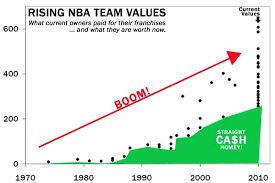 On April 9, 2013, Marquette University Law School and the Milwaukee Journal Sentinel sponsored a symposium titled “A New Milwaukee Sports and Entertainment Arena? Defining the Benefits and Dividing the Costs.”[1] The purpose of the symposium was to discuss the future of the Bradley Center and the Milwaukee Bucks in Milwaukee, Wisconsin. I was a presenter at that symposium and represented ownership views and prognosticated that the sale of the Milwaukee Bucks would garner in the area of $350 million.[2] (View my presentation slides and read my notes.)
On April 9, 2013, Marquette University Law School and the Milwaukee Journal Sentinel sponsored a symposium titled “A New Milwaukee Sports and Entertainment Arena? Defining the Benefits and Dividing the Costs.”[1] The purpose of the symposium was to discuss the future of the Bradley Center and the Milwaukee Bucks in Milwaukee, Wisconsin. I was a presenter at that symposium and represented ownership views and prognosticated that the sale of the Milwaukee Bucks would garner in the area of $350 million.[2] (View my presentation slides and read my notes.)
The Milwaukee Bucks were purchased by Senator Herb Kohl for $18 million in 1985. The Bucks are a small market team, no franchise star, no state-of-the-art arena, a twenty-five year legacy of losing—but for 2001, one of the smallest revenue producing teams in the NBA, and of late—apathetic fans. Kohl put the team up for sale and the subsequent auction of the team was handled by Steve Greenberg of Allen & Co.
Approximately nine bidders were at the table, and hedge fund billionaires Marc Lasry and Wesley Edens were the ultimate highest bidders at $550 million, with a $150 million contribution towards a new arena. Maybe the sale of the Sacramento Kings in May of 2013 for $534 million should have been a premonition for the Bucks purchase price. The Bucks’ sale was followed in August of 2014 by Donald Sterling’s forced sale of the Los Angeles Clippers for a record $2 billion to former Microsoft CEO Steve Ballmer. Forbes had previously valued the Clippers for $575 million. And now comes the sale of the Atlanta Hawks.
So why are NBA prices escalating?
- Worlds most exclusive club – There are only 30 NBA teams. It is a matter of supply and demand, a lack of inventory. While the rich can buy planes and islands, buying an NBA team is difficult, competitive, and often an ego purchase. Owning an NBA team is not only prestigious, but gives the owner the opportunity to sit at the table with the Board of Governors.[3]
- A New TV Deal – In October of 2014 the NBA announced a nine year, $24 billion ESPN/Turner TV package, which will generate approximately $2.67 billion per year through the year 2025 and starts in the 2016/2017 season. The $2.67 billion (a 180% increase) increases the current payment to the league from $930 million per year.
- Local Media/TV Deals Growing – Unlike the NFL where the television revenue is shared equally, NBA franchises may sell their own local television rights, such as the $4 billion deal that the LA Lakers inked, which result in approximately $122 million in local television revenue. Sports teams are now more like small media empires and media packages are part of the game.[4]
- New CBA – With a new owner favorable CBA agreement following the NBA lockout, the owners and players agreed to reduce the amount of revenue shared with the players from 57% under the previous collective bargaining agreement to a 49-51% split under the new CBA. By virtue of the new revenue split in the CBA, the owners profit should improve, thus making the teams more valuable. The new CBA also realigned revenue sharing – giving small market teams an ability to survive and succeed.
- Internationalization and Globalization of the Game – Not only are there many foreign players on teams in the NBA, but the NBA is starting to play exhibition contests in foreign countries. The most recent of which was the Milwaukee Bucks vs. the New York Knicks in London in January of 2015. Watch for further internationalization and expansion to Europe and Asia which will just further increase the revenues of the league.
- Tax Shelter – The availability to write off essentially the purchase price of the team over 15 years at the owners selected schedule makes the ownership of a professional franchise one of the best of the available tax shelters, and therefore has become an attractive investment for the most wealthy, including hedge fund owners.
In January of 2015, Forbes came out with a new franchise evaluation. According to Forbes, the franchise values of NBA teams rose an average of 74% in one year. This constitutes the biggest one year value jump since 1998 and the average NBA team is now estimated to be worth $1.1 billion.[5]
[1] A new Milwaukee Sports and Entertainment Arena? Divining the Benefits and Dividing the Costs. April 13, 2013. http://law.marquette.edu/current-students/new-milwaukee-sports-and-entertainment-arena-divining-benefits-and-dividing-costs
[2] See attached PowerPoint Presentation and Speech Notes.
[3] The World’s Most Exclusive Club by Bill Simmons, April 17, 2014. http://grantland.com/features/the-worlds-most-exclusive-club/
[4] Why NBA Franchise Values are Skyrocketing by Cork Gaines, June 10, 2014. http://www.businessinsider.com/why-nba-franchise-values-are-skyorcketing-2014-6
[5] Forbes releases 17th Annual NBA Team Valuations, Forbes, January 21, 2015. http://www.forbes.com/sites/forbespr/2015/01/21/forbes-releases-17th-annual-nba-team-valuations/


